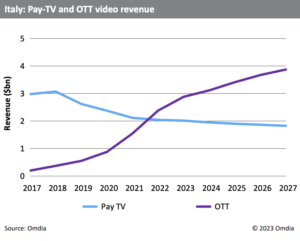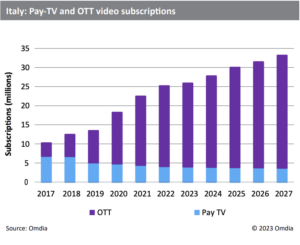
After more than 40 years of operation, DTVE is closing its doors and our website will no longer be updated daily. Thank you for all of your support.
OTT in Italy: surpassing pay TV
OTT video is continuing to grow in Italy, driven by sports streamer DAZN’s performance. OTT revenue surpassed pay TV for the first time in 2022, despite a slowdown in the rate of growth, according to Omdia research.
 OTT video subscriptions grew by three million to reach 21 million customers in 2022, a decline from the previous year’s uptake of 4.6 million subscribers. Revenue, in contrast, grew at an even greater rate than the previous year, with profits increasing by US$831 million (compared to US$670 million for the prior year), to reach US$2.4 billion by the end of 2022.
OTT video subscriptions grew by three million to reach 21 million customers in 2022, a decline from the previous year’s uptake of 4.6 million subscribers. Revenue, in contrast, grew at an even greater rate than the previous year, with profits increasing by US$831 million (compared to US$670 million for the prior year), to reach US$2.4 billion by the end of 2022.
The pay TV market, which consists solely of Sky Italia, declined for a third consecutive year in 2022, losing 302,000 subscriptions and reaching 4.1 million subscribers by year-end. Revenue, likewise, declined during the year, with a 3.5% decrease to US$2 billion. Sky still generates the most revenue in Italy, with pay TV holding a 46% share (US$2bn) of the total TV and online market.
Sky’s subscriber base took a major hit when it lost the prime rights to Serie A in 2020, with many customers migrating to DAZN due to this acquisition. However, DAZN’s distribution partner Telecom Italia (TIM) decided to renegotiate its deal in August 2022, losing its exclusivity to DAZN on its TIMVision service. This paved the way for DAZN to partner with Sky in the same month, making the sports streaming app available again via its Sky Q platform.
Sky meanwhile released Sky Glass. its integrated smart TV, in Italy in September 2022. This set to play a critical role in the company’s strategy for customer growth in the future.
Rival TIMVision saw only marginal growth in 2022, with a 5.9% (82,000) increase on the previous year. Its deal with DAZN, through which it hoped to grow subscriptions, was negatively impacted by rampant piracy and technical problems.
OTT players
 On the OTT side, Netflix meanwhile saw a small decline in customers during the second quarter of the year, losing 36,000 customers (0.7%), but bounced back with more substantial growth in the preceding quarters: it gained 112,000 (2.3%) in 3Q22 and 471,000 (9.5%) in 4Q22. Netflix, therefore, grew by more than half a million customers (12.1%) by the end of the year, reaching 5.4m customers in total, putting the streamer above Sky (exclusive of NOW) for the first time.
On the OTT side, Netflix meanwhile saw a small decline in customers during the second quarter of the year, losing 36,000 customers (0.7%), but bounced back with more substantial growth in the preceding quarters: it gained 112,000 (2.3%) in 3Q22 and 471,000 (9.5%) in 4Q22. Netflix, therefore, grew by more than half a million customers (12.1%) by the end of the year, reaching 5.4m customers in total, putting the streamer above Sky (exclusive of NOW) for the first time.
Like its OTT competitors, Amazon Prime Video saw growth in customer uptake slow during 2022, adding 227,000 subscribers to reach 2.4 million by the end of the year. Amazon did however hold onto its “first pick” rights for Champions League coverage in Italy in February 2023, signing a new deal with UEFA for the 2024–27 broadcast cycle.
Since acquiring Serie A in April 2021, DAZN itself saw a substantial rise in its subscriber base, adding two million customers (130.6%) in 2021 and 553,000 customers (15.8%) in 2022. However, the huge cost of acquiring these rights meant that DAZN had to increase its price at the start of the league, trebling it from €9.99 to €29.99 per month. Even with an increase in revenue, DAZN ultimately reported that the high cost of acquiring Serie A and the German Bundesliga had caused the company to suffer significant operating losses. While we expect price rises to help to reduce these losses, DAZN faced a loss of consumer confidence as technical problems continued to plague the service over the summer
Finally, Disney+ had another year of strong growth in 2022, adding 691,000 new customers. Revenue, likewise, continued to grow, with the company generating US$160 million in 2022 – a 46.3% increase from the previous year. Disney launched its own AVOD tier in the US in November, with plans to launch in Europe sometime in 2023.
Rob Moyser is senior analyst, TV and online video at Omdia.
This article is taken from the Omdia Report Italy: Trends in Pay TV and Online Video – 2023. Find out more here


